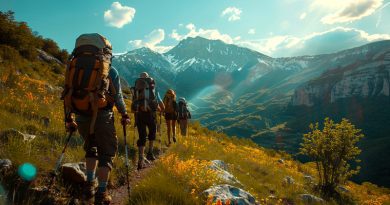
How Do I Navigate While Camping in the Backcountry?
Navigating the backcountry is not just about moving from point A to point B; it’s about understanding your environment, making informed decisions, and returning safely. The challenge is as thrilling as it is formidable.
Navigating the backcountry presents a blend of challenges and solutions, each tailored to the adventurer’s needs and the nature of the terrain. Let’s delve deeper into each navigation method and how to implement a combined approach effectively.
Traditional Map and Compass
The traditional map and compass method is a time-tested approach that doesn’t hinge on modern technology, making it reliable in the most remote or challenging environments. However, this method demands a solid skill set:
- Orienteering Skills: You need to know how to align the compass with the map’s magnetic north and real north (adjusting for magnetic declination).
- Topographic Map Understanding: Being able to interpret contour lines, scales, and symbols on a topographic map is crucial. These maps provide detailed information about terrain elevation and major landmarks, which are essential for navigation in areas without clear trails.
- Challenges: The accuracy of navigation depends on your ability to interpret the landscape around you. Misreading features or poor visibility can lead to errors in navigation.
GPS Devices
GPS devices offer precision with convenience, providing real-time location tracking that helps pinpoint your exact location on a digital map.
- Advantages: They are especially useful in conditions where the landscape does not have distinct features or when visibility is compromised by weather.
- Limitations: Their reliability decreases in locations with poor satellite reception, such as deep canyons or dense forests. Moreover, they are battery-operated, which poses a risk if power runs out and no backup power sources are available.
Smartphone Apps
Smartphone navigation apps are increasingly popular due to their user-friendly interfaces and multifunctional capabilities.
- Convenience: Most smartphones have built-in GPS which can be used for navigation. Apps often come with features like altitude meters, speedometers, and even augmented reality for enhanced trail recognition.
- Drawbacks: These apps consume significant battery power and generally require cellular data for map downloads unless maps are pre-downloaded for offline use. Their effectiveness diminishes outside of cellular range, making them less reliable in remote backcountry areas.
Best Solution and Implementation: Combined Navigation Approach
Given the distinct advantages and vulnerabilities associated with each navigation method, combining them ensures greater reliability and safety during backcountry excursions.
Pre-Trip Preparation
- Dual Mapping: Prepare by studying your route using both a physical and a digital map. This will help you understand the terrain from different perspectives.
- Waypoint Marking: Mark important waypoints and landmarks on both maps. This includes starting points, destinations, water sources, and potential campsite locations.
Using GPS Devices
- Real-Time Tracking: Utilize GPS for real-time location tracking while actively navigating. This helps in making on-the-spot decisions about direction and route adjustments.
- Battery Conservation: To extend battery life, use the GPS intermittently—check your position periodically rather than keeping it on continuously.
Mastery of Map and Compass
- Skill Refinement: Regularly practice using a map and compass together. Learn how to find your position on a map using surrounding landmarks and how to set a bearing with your compass.
- Cross-Referencing: Periodically check your physical location against your map. This practice helps in maintaining a correct course and can be invaluable if the GPS fails.
By mastering these tools and techniques, you can confidently navigate the complexities of the backcountry. This combined approach not only enhances your safety but also enriches your outdoor experience, allowing you to engage more deeply with the wilderness around you.
Listing Resources or Tools Needed
To navigate effectively in the backcountry, ensure you have:
- Topographic Map: updated and covering the area you’re exploring.
- Compass: reliable and preferably with adjustable declination.
- GPS Device: Preloaded with maps and extra batteries or a charging method.
- Smartphone with Navigation Apps: Preloaded with offline maps.
- Power Bank: To keep electronic devices charged.
- Waterproof Map Case: To protect your maps from the elements.
Conclusion
As I descended back towards civilization, the river to my left whispered stories of lost travelers who once wandered these woods. The importance of navigation became as clear as the mountain stream. Navigating the backcountry requires not just tools and technology, but a synergy of skills, preparation, and respect for the untamed wilderness. By blending traditional techniques with modern technology, you ensure a journey not just back to where you started, but into a deeper understanding of the natural world. In the backcountry, every step is a narrative, and how you navigate writes your story.






